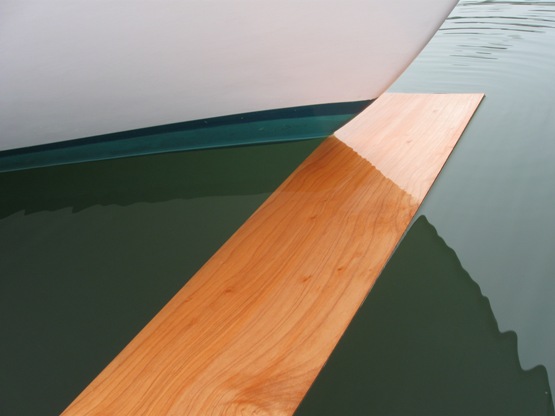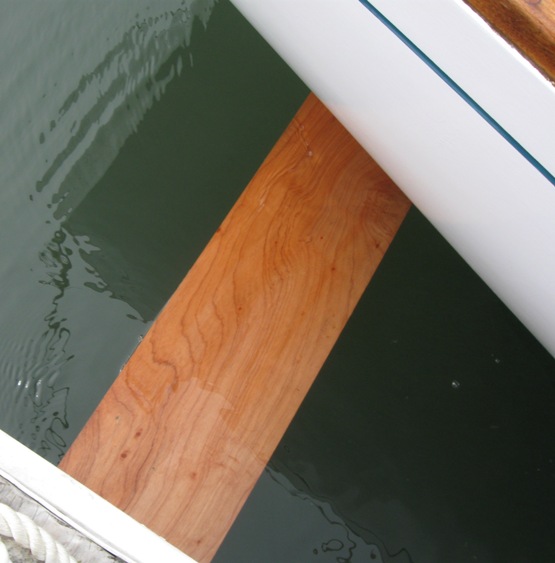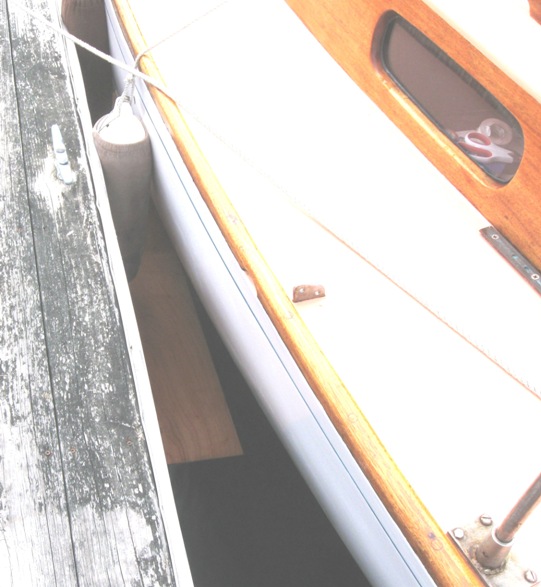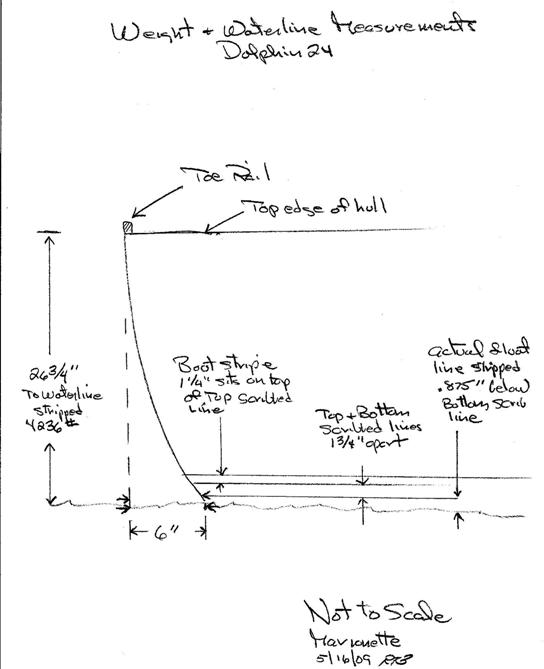May 16, 2009. When the guy in the slip next to your asks you what's the waterline length of your boat you say 19' because that's what the literature says. But what is it really? And under what conditions - stripped? with 'standard gear'? Race ready? Cruise ready? crew aboard?
Here is a way to measure it. A quiet day, early in the morning, no one around the yacht club or marina to see what's going on, and witness what must be someone certifiably insane trying to measure the waterline length of his boat.... This was actually easier than I thought it would be.
First, I stripped the boat to get it to the weight condition we had when we weighed it on May 12 - 4234 lbs - no spar, no gear, just battery, battery cables, and lifelines. I tied off the dock lines so that they were parallel to the waterline, not pulling the boat up or down, and so that the boat was close to, and parallel to, the dock.

I needed a light measuring board 5-6 ft long and about 12" wide. I wanted the board's top edge to float close to its own waterline, have a wide enough base to square up to the dock, and long enough to reach out past the centerline on the boat. I just happened to have a piece of plywood 1/4" x 10" x 60" in the barn with square corners and straight cut lines. I knew this would be close and It turned out exactly the right size.
Lying prone on the dock, observing carefully the effect of the light 'surge', the measuring board was placed so it floated to the leading edge of the bow while the short end is square to the dock. Noting the particular existing identifying feature on the dock face where the aft edge of the board touches I used my fine line magic marker to mark the spot.

The same procedure at the stern, however, more difficult as the slope of the hull through the waterline is much more gentle and the leading edge of the board can slide under the waterline. Seeing this requires one to hang over the dock a bit more to peek under the overhanging hull. One needs to be more sensitive with the forward pressure on the board, but it worked.
A tape measure to measure between the marks and you have it! Marionette's waterline length, stripped, is 19'2".
Note: I was not able to get this done and take the pictures at the same time. So the pictures are 'staged' with the measuring board in place - but they are exactly representative.

This picture is of the measuring board in place at the max beam. This is where I got lucky. The 10" wide board floated perfectly between the waterline and the edge of the dock. In real life the fender was not there so I pulled lightly outward on the toerail until the board's long edges kissed the dock face and the hulI and measured the distance between the vertical face board of the dock (not the rub rail) and the hull. It was 4". The difference is 6". If we can assume that the beam of the boat, 7' 8", is correct on the drawings (maybe we will have to find a simple way to actually measure this too), then the beam at the water line is 6'8" {7' 8" - (2 x 6")}
I also measured the height of the freeboard to the waterline while I had this last set up. This is the distance between the top edge of the hull and the waterline at the point of max beam. This was 26 3/4 inches. This compares to 27 inches in the S&S Dolphin Design #1497 DWL.
The Datum Water Line (DWL) length on the design drawing is 19' 0". Presumably this DWL was not just the boat, but also the rig, engine and probably some other equipment. We are working on finding out what that was. The S&S spec standard Dolphin had a Palmer PW 27 8 hp engine, a 10 gal tinned copper fuel tank (Passage, #10, had a molded fiberglass tank), and a 20 gal molded glass water tank. Together with the rig this adds 400+ lbs of additional displacement.
This additional weight should add approximately one inch of additional displacement, perhaps 5-6 inches of waterline length, reduce the freeboard at the max beam, and increase the beam waterline to about 6' 10". We shall see.
It seems from what we have done so far, the early Dolphins had more displacement and waterline length than the design numbers, even before some racing owners added internal ballast. Olin Stephens' memo of Dec 5, 1967, excerpted below indicates that as well. To see the full text, click here.

The measurements will be repeated at least three times 1) when the boat has her rig and engine, 2) when she has a total load such that her rig, engine and other to total 400+ lbs simulating the standard Dolphin 3) when she has her normal racing load, ex crew , and 4) normal cruising load ex crew.
This sketch summarizes where we are right now

We don't know exactly where we are going with all this - we will find out when we get there. Stay tuned...
*********************
May 25, 2009 Finally got the rig in - this is done at a crane at the yacht club and the actual process takes only maybe 15 - 20 minutes not counting the time to get the boat and mast repositioned. A volunteer crew of 5, although I have done it with 3. Ideally, you have 1) a hoist up/down control guy - the button man - a plush job; 2) a crane control guy he positions the crane boom over the boat 3) a 'butt' guy - on the boat he gathers in the butt end of the mast and positions/holds it down on the step while 4) and 5) pin men pin the turnbuckles and hand tighten.
The hook on the power hoist hooks through a loop tied around the mast below the spreaders with a long tail that ties off to a cleat at the bottom of the mast. The button man raises the horizontal mast a bit to check balance This allows for adjustment of where exactly the loop/hoist block is positioned. Ideally, the mast should slightly butt heavy. A line from the butt to the butt man guides the butt down as the boom swings over and the button man lowers the mast with the power hoist. You need about 15' of distance between the double blocked hoist and the top of the deck
Its nice to have a nice calm morning, no wakes.
******************
May 30, 2009. Finally, a nice calm morning, 7AM, no wakes, no rain. Our goal here was to measure the the waterline length and freeboard with the weight on board that might have been included in the original design drawings.
This is the build up of weight (more details on weight are included in the weight chart)
| weight groups |
weight |
detail |
| base boat |
4236 |
inc battery/charger (63); lifelines/6 stanchions (est 20); bow pulpit )est 10) |
| May 16, 2009 |
|
waterline length 19'2"; freeboard at max beam 26.75"; max beam 6'8" |
| rig |
150 |
mast, standing rigging, halyards (121); boom, main sheet, van (29) |
| sub total |
4386 |
|
| 4 hp engine |
32 |
|
| tank/fuel |
26 |
|
| transom hull plug |
5 |
|
| anchor/rode |
39 |
|
| tool box |
12 |
|
| parts box |
18 |
|
| rigging bag |
18 |
balance of rigging weight 26 lbs included in rig above |
| lines bag |
22 |
|
| cabin box |
83 |
see detail |
| fenders, etc |
9 |
3 fenders, 2 throwable cushions |
| cleaning kit |
18 |
|
| 50' ext cord |
15 |
|
| sub stuff |
297 |
|
| sub stuff + rig |
447 |
|
| Total Boat/stuff |
4683 |
simulates an early Dolphin with inboard engine and related gear |
| May 30, 2009 |
|
waterline length 19'5"; freeboard at max beam 25.75."; max beam 6'9" |
If these measures can be believed we added 447 lbs of additional weight/displacement which added 3' of waterline length and made the boat float 1" deeper in the water. This brings the float line to approximately the bottom line scribed in the hull in the sketch above.
Marine architects use a formula - the waterplane coefficient - to calculate the additional displacement that a boat adds when she floats 1" deeper in the water. The formula is LWL x max beam at the WL x a coefficient x 64.2 (weight of a cubic ft of seawater/12.
The coefficient starts a 1.0 - this would be a rectangular barge - and works down progressively. A 'typical" racer cruiser might be around .65 to .70. Using the above measurements a Dolphin's waterplane coefficient at a freeboard height of 25.75" is .67. Kudos to Mark Steinhilber (Rascal) who called this one spot on.
Based on popular demand, someday, we will repeat these measurements with the additional weight/displacement for a fully race equipped boat, and a fully cruised equipped boat.
*********************************
March 5, 2016. This has been bothering me for coming up on 5 years - an unfulfilled promise to measure fully loaded waterline length - probably had something to do with lack of popular demand. Anyway, working in the barn on a cold early March morning on another project (trailer measurements....) it occurred to me that I could measure Marionette's fully loaded draft and waterline while she is on the trailer!
The light scum line was clear evidence of where the waterline was. I could set up a sawhorse in line with the bow waterline scum mark and stretch my 30' tape to another sawhorse lined up with the aft end of the rudder which is below and exactly in line with the waterline - light scum line. (Marionette's boot stripe sits on top of the top scribbed line in the hull so the light scum line is not on the ootstripe but just below it on the top of the bottom paint) The result:
Marionette's 'loaded" waterline length is 20'4"
This is her waterline length without crew aboard. Her scum line develops when she is at her slip - alone. From our http://dolphin24.org/weight.html table we know that Marionette weighs, at the dock, 5,032lbs. Lets assume a crew of 3, plus their gear and some ice/food, etc, adds 600lbs, bringing Marionette up to 5632, race ready.
And, assuming that the hull shape changes are uniform at this level, we know 447lbs of additional weight added 3" of waterline length and 1' of depth. Assuming a linear relationship the additional 600lbs should add about 4" to waterline length - bringing it up to 19'7". (Webmaster Note: we are just checking what the master (Olin) said above "at least 19'6")
So, why to we care? The 'standard' hull speed formula for an efficient hull shape (Dolphin 24s are very efficient!) is 1.34 X square root of the waterline length. At 19' that's 5.84 knots. At 19'7" that's 5.95 knots. Maybe since Dolphin hulls are so efficient we can round up to 6 knots? Sounds so much better.....
Then, I measured 'her' draft, board up by measuring the distance from bottom of her keel to the concrete floor and subtracting this from the measured distance between the concrete floor and the (scum)waterline. It was exactly 3'. The design drawing say 2'10". We know from the weight page that 447 lbs increased draft by 1", our fully loaded with crew increase of 600lbs will increase draft by another 1"+. The centerboard down position adds 2'4" so Marionette's max draft, board down in 5'4", board up 3'. (Assuming, of course the boat is not heeled!! I wonder what....)
Ok, you can go to sleep now....
************************************
